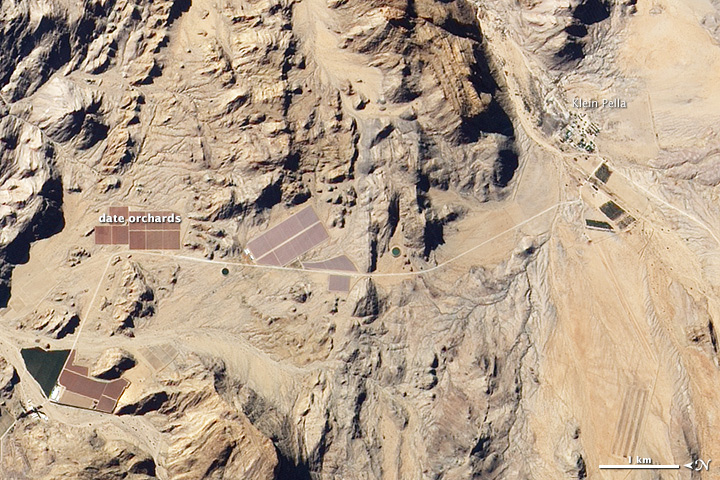


Editor’s Note: Today’s caption is the answer to Earth Observatory’s February Puzzler.
The village of Klein Pella in South Africa’s Northern Cape province has one of the harshest climates in the country. Rain is scarce, with less than 10 millimeters (0.4 inches) falling most months. Meanwhile, temperatures are typically hot in mid-summer, with highs averaging about 38°C (99°F).
Aside from a handful of hardy annuals and shrubs, few plants manage to survive on their own. So it is not exactly the first place you would think to establish a settlement. Yet that is precisely what missionaries did in 1814 after being driven from Warmbad, a town to the north. Nearby Pella had a natural spring and was just a few kilometers from the Orange River, the longest in South Africa.
Today, water from the Orange River irrigates more than 87 hectares (215 acres) of Phoenix dactylifera, the type of palm that produces the Medjool date. The Advanced Land Imager (ALI) on the Earth-Observing-1 satellite captured this view of the orchards on June 7, 2013. Cultivated areas appear as brown and light purple blocks amidst the otherwise barren, rocky landscape. In the lower image, the Orange River is located a few kilometers to the north. The upper image, our February Puzzler, was rotated to make it more challenging for readers to identify.
The orchards, operated by Karsten, are home to about 14,000 trees. Though Karsten is the largest producer of dates in the Southern Hemisphere, South Africa’s overall production lags behind the leading date-producing countries of Egypt, Saudi Arabia, and Iran.
NASA Earth Observatory image by Jesse Allen and Robert Simmon, using EO-1 ALI data provided courtesy of the NASA EO-1 team and the U.S. Geological Survey. Caption by Adam Voiland. Congratulations to JMR for being the first reader to solve the puzzler.